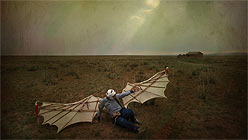The VIP opening for the Present Tense Biennial: Chinese Character show at the Chinese Culture Center was slated for 6:30pm. But a cordon of CCC staff and board members and local politicoes — plus curator Kevin Chen and (presumably) all the artists present — barred a packed lobby-ful of attendees from the gallery for an hour, giving speech after speech (and issuing city supervisor-signed certificates). When the gallery finally opened, the entire audience rushed into the exhibition space like a small boar down a boa constrictor’s throat. Worse: the snakelike gallery (entrance at the front, exit at the back) was blocked at the exit end, encouraging viewers to linger in the galleries socializing after they’d finished looking around. It was impossible to see the work.
I go into such gory detail because the scene illustrates the glorious contradictions of mounting a show like Present Tense Biennial. The Chinese in me was amused at the necessity of making sure the city graced this new enterprise, and making sure everyone involved was given face, publicly. The contemporary art viewer in me was annoyed as hell that I had to wait around and then try to see the show through crowds of schmoozers. At the moment, I have little information about how this marriage was arranged, or where the self-proclaimed “biennial” will go in two years. All I know is that, by its very circumstance, the show is both a meld and a clash of three different approaches to representing community.
The Chinese Culture Center is a contemporary manifestation of “Old Chinatown,” a way of organizing an increasingly well-educated immigrant population within the traditional ethnic enclave, using the guanxi (or web of favors and connections) that runs through all sectors and classes of the San Francisco Chinese community. Exhibition co-sponsor Kearny Street Workshop (full disclosure, I was on staff 1999-2003) is a nearly forty-year-old “Asian American Movement” dinosaur, a creation of the early 70s’ critical mass of American-born Asians trying to communicate both with traditional ethnic communities and with the American mainstream, while carving out a third niche to declare and define their own identity.
And then there is curator Kevin Chen. Although Intersection for the Arts is not directly involved in Present Tense Biennial, Chen brings to the show a powerful whiff of the ethos he’s helped develop at Intersection in the past decade; an unacknowledged, post-colonial, “post-racial” perfume of a practice that insists on nothing but the ability of the work to play in a contemporary international context.
I put “post-racial” in scare quotes because, in the past ten years, our community arts curators and editors have been doing a St. Vitus’ Dance around the question of when identity art begins to eat itself. And no wonder: as long as we don’t grapple directly with this question, we can continue to push the boundaries of what is considered identity art, and satisfy both the clarion call of racial solidarity, and the siren song of aesthetic indulgence. Such curators have been taking advantage of the now-aging tradition of ethnic-specific cultural productions, to sneak in work by artists not of that ethnic description that might bolster or illuminate the body of work being shown. It’s also a small rebellion against pure racial lines, and a sly challenge to the viewer to question racial taxonomies.


